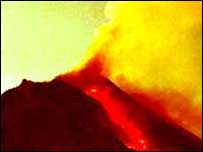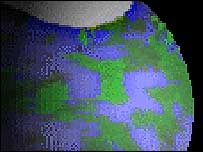|
By Dr David Whitehouse
BBC News Online science editor
|

The Cambrian Explosion - when life suddenly and rapidly flourished
some 550 million years ago - may have an explanation in the reaction of
primitive life to some big event.

Something triggered the explosion of life
|
The explosion is one of the most significant yet least understood periods in the history of life on Earth.
New research suggests it may have occurred because of a
complex interaction between components of the biosphere after they had
been disturbed by, for example, the break-up of a super-continent or an
asteroid impact.
Scientists say the life explosion might just have easily occurred two billion years earlier - or not at all.
Dramatic events
All modern forms of life have their origin in the sudden
diversification of organisms that occurred at the end of the so-called
Cryptozoic Eon.
Scientists have struggled to explain what might have
happened in the previous few hundred million years to trigger such a
burst of life.
 |
BIOLOGY'S 'BIG BANG'
Major animal groups, or phyla, trace lineage to Cambrian Period
Age of trilobites, sea-dwelling arthropods used to date rock layers
Medieval Latin name for Wales, where Cambrian rocks first described
|
Certainly, it was a period of history that witnessed the assembly and
break-up of two super continents and at least two major glaciation
events. Atmospheric oxygen levels were also on the rise.
But what actually caused the Cambrian Explosion is unknown.
Writing in the journal Geophysical Research Letters, Dr
Werner von Bloh and colleagues, from the Potsdam Institute for Climate
Impact Research, present a new analysis of happened.
They suggest that "feedback" in the biosphere caused it
to jump from one stable state without complex life to one that allowed
complicated life to proliferate.
"We believe that there was a change in the environment -
a slow cooling of the system - that caused positive feedback that
allowed the conditions for complex life," Dr von Bloh told BBC News
Online.
Self regulation
Using a computer model of the ancient Earth, the researchers considered three components of the biosphere, the zone of life.
These were single-celled life with and without a
nucleus, and multicellular life. Each of these three groups have
different environmental tolerances outside which they cannot thrive.

Simulating the primitive Earth's biosphere
|
The computer model showed there were two zones of
stability for the Earth - with or without higher lifeforms - and that
542 million years ago the planet flipped from one to the other.
What caused the flip is not clear. It might have been a continental break-up, or even an asteroid impact.
There is some indication that the Moon suffered a sudden
increase in impacts about the same time as the Cambrian Explosion. If
so, then the Earth would have been affected as well.
This latest analysis also provides some support for the
Gaia hypothesis - the idea that the biosphere somehow acts as a
self-sustaining and regulating whole that opposes any changes that
would destroy life on Earth.
Intelligent beings
Dr von Blow says that after the Cambrian Explosion there
has been a stabilisation of temperature up to the present, and that the
biosphere is not playing a passive role.
He also adds that there is an intriguing implication
from his research which suggests that had the conditions been only
slightly different, the Cambrian Explosion could have occurred two
billion years earlier.
An early explosion would have meant that by now the
Earth could have developed far more advanced intelligent creatures than
humans.
Alternatively it could still be inhabited by nothing more complex than bacteria.
Dr von Bloh says that it will be of great interest when
we find other Earth-like worlds circling other stars to see if they
have had their own Cambrian explosions yet.
The timing of such events has implications for the search for intelligent life in space, he says.
|